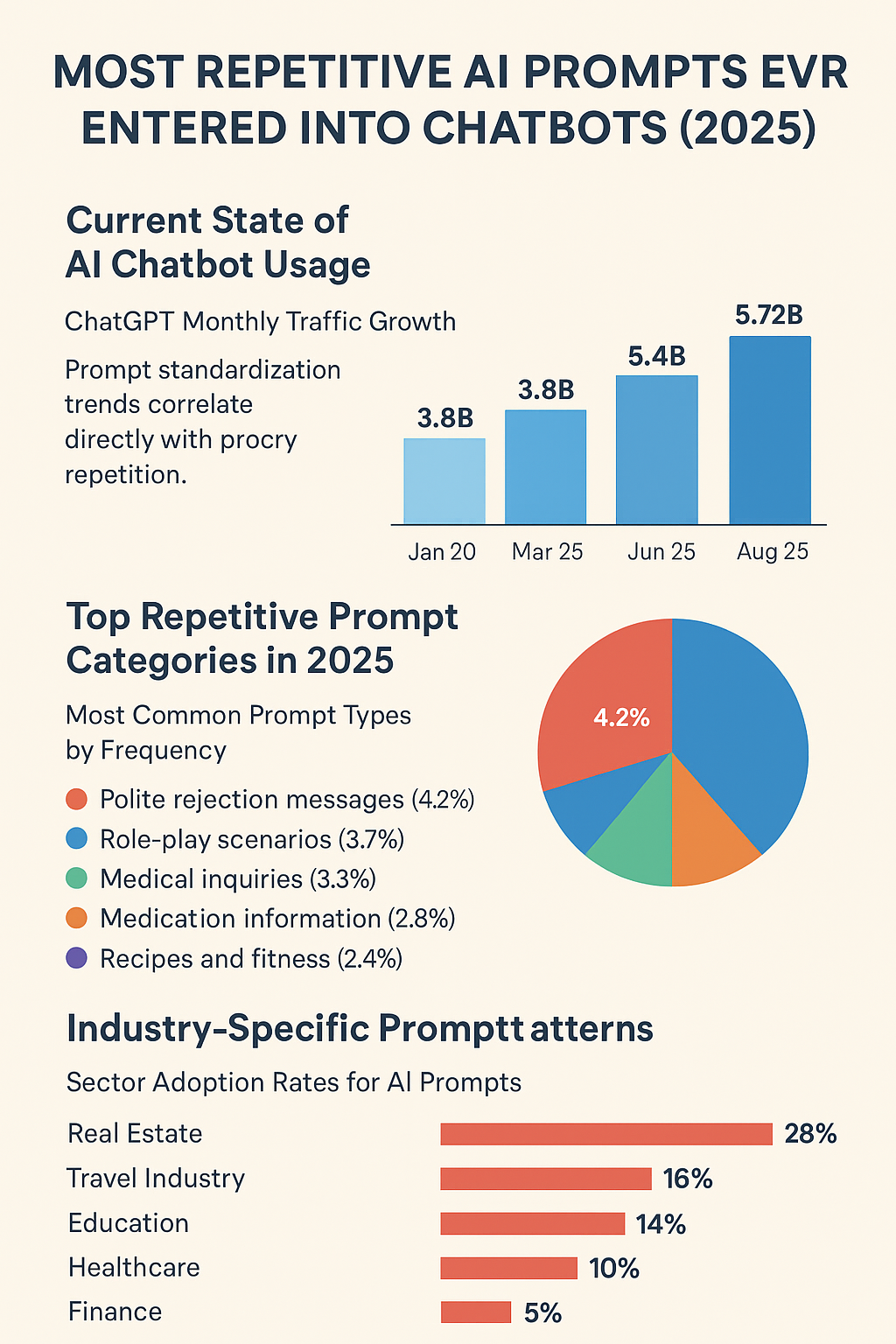Current State of AI Chatbot Usage
The scale of AI usage statistics in 2025 demonstrates unprecedented growth. ChatGPT alone processes over 5.72 billion monthly visits, representing a remarkable increase from previous years. This massive volume generates equally substantial prompt repetition patterns across multiple platforms.
ChatGPT Monthly Traffic Growth
These traffic patterns correlate directly with prompt standardization trends. As user bases expand, template-based interactions become increasingly common across educational institutions and business environments.
Top Repetitive Prompt Categories in 2025
Comprehensive analysis of chatbot interactions reveals five dominant categories that account for significant portions of all queries. These categories demonstrate how users gravitate toward proven prompt structures rather than experimental approaches.
Most Common Prompt Types by Frequency
Polite rejection messages (4.2%)
Role-play scenarios (3.7%)
Medical inquiries (3.3%)
Medication information (2.8%)
Recipes and fitness (2.4%)
| Prompt Category | Percentage of Total Queries | Monthly Volume (Estimated) | Primary Use Cases |
|---|---|---|---|
| Draft polite rejection messages | 4.2% | 240 million | Professional communication |
| Role-play as fictional character | 3.7% | 211 million | Creative writing, entertainment |
| Medical condition descriptions | 3.3% | 189 million | Health information seeking |
| Medication properties | 2.8% | 160 million | Pharmaceutical research |
| Recipes and fitness advice | 2.4% | 137 million | Lifestyle optimization |
Industry-Specific Prompt Patterns
Customer Service Applications
Business adoption of AI tools used at work has reached critical mass. Current projections indicate that 95% of customer interactions will be AI-driven by 2025, creating massive demand for standardized prompt templates.
Sales organizations report that 41% of businesses utilize chatbots for sales processes, resulting in average sales increases of 67%. This success drives repetitive prompt patterns including product demonstration scheduling and lead qualification scripts.
Educational Sector Repetition
Students represent a significant portion of AI chatbot users, with specific platforms dominating academic usage. Educational prompts frequently involve homework assistance, research guidance, and study material creation.
Sector Adoption Rates for AI Prompts
Technical Analysis of Prompt Engineering Patterns
Advanced analysis reveals that prompt engineering follows 58 distinct techniques, with certain structures appearing consistently across domains. Meta-prompts and chain-of-thought formatting represent the most frequently recycled approaches.
Common recurring triggers include analysis requests, reasoning chains, and comparison frameworks. These structures mask creative exploration while enabling reproducible results, fundamentally altering how users approach AI interaction.
Browser-Based AI Integration
The integration of AI tools with Chrome browser statistics reveals interesting usage patterns. Users often access AI chatbots through browser tabs, with tab management affecting productivity when working with AI tools.
Research on Chrome extension ecosystems shows growing integration between AI platforms and browser functionality, influencing prompt standardization across web-based applications.
Privacy and Trust Considerations
Trust metrics for AI chatbots vary significantly based on use case. Studies examining AI chatbots most trusted for sensitive data reveal that prompt repetition often correlates with user confidence levels.
Understanding Chrome permissions and user behavior provides insight into how prompt patterns develop across different security contexts.
Comparative Platform Analysis
While ChatGPT dominates market share, other platforms show distinct usage patterns. Claude statistics and usage trends demonstrate different prompt repetition rates, suggesting platform-specific user behaviors.
Analysis of Google Gemini statistics and Perplexity user trends reveals varying approaches to prompt standardization across competing platforms.
Text-to-Image Generation Repetition Rates
| Domain | Repetition Rate | Common Examples | Impact Factor |
|---|---|---|---|
| Text-to-Image Generation | 40-50% | Community tag prompts | High visual similarity |
| Customer Service FAQs | 45-60% | Order status, demo scheduling | Operational efficiency |
| Creative Text Requests | 30-45% | Story prompts, writing assistance | Moderate standardization |
| Technical Documentation | 35-55% | Code explanations, tutorials | Consistency requirements |
Future Implications and Workplace Impact
The discussion around whether AI will replace human workers becomes more nuanced when considering prompt repetition patterns. Standardized interactions suggest complementary rather than replacement relationships in many contexts.
Organizations must balance efficiency gains from prompt templates with the need for creative and diverse AI interactions. The challenge lies in maintaining innovation while leveraging proven prompt structures for consistent results.
Strategies for Managing Prompt Repetition
Research suggests several approaches for organizations seeking to balance efficiency with diversity in AI interactions. Monitoring prompt logs can detect up to 84% of manipulative or repetitive patterns, enabling proactive management strategies.
Introducing variation tags in templates and encouraging A/B prompt testing helps organizations maintain effectiveness while reducing excessive standardization. These approaches support both operational efficiency and creative exploration.
Frequently Asked Questions
Why do users repeat the same AI prompts?
Users gravitate toward proven prompt structures because they deliver consistent results. Template-based approaches reduce uncertainty and provide reliable outcomes, making them preferable for routine tasks. This behavior mirrors how people develop communication patterns in human interactions.
How does prompt repetition affect AI output quality?
Repetitive prompts can limit creative output diversity while improving consistency. Research shows that higher linguistic repetition in text-to-image generation leads to visually similar outputs with lower diversity scores. The impact varies by application context and user objectives.
Which industries show the highest prompt repetition rates?
Customer service, healthcare, and finance sectors exhibit the highest repetition rates due to regulatory requirements and standardization needs. Real estate leads with 28% adoption, while finance shows 5% adoption, reflecting varying comfort levels with AI standardization.
Can prompt repetition be reduced without losing effectiveness?
Yes, through variation tags, A/B testing, and rotation strategies. Organizations can maintain core prompt effectiveness while introducing controlled variations that preserve functionality while reducing excessive standardization.
What role does platform design play in prompt repetition?
Platform interfaces significantly influence user behavior. Features like prompt suggestions, templates, and auto-completion encourage repetitive patterns. Different platforms show varying repetition rates based on their user interface design and target audiences.
How do prompt patterns differ between personal and professional use?
Professional contexts show higher repetition rates due to compliance requirements and consistency needs. Personal use exhibits more variation but still follows templates for common tasks like creative writing or problem-solving.
References
- Servion Global Solutions. “AI will power 95% of customer interactions by 2025.” https://aibusiness.com/automation/ai-will-power-95-of-customer-interactions-by-2025
- Master of Code Global. “AI in Customer Service Statistics [June 2025].” https://masterofcode.com/blog/ai-in-customer-service-statistics
- MIT Sloan. “Study: Generative AI results depend on user prompts as much as models.” https://mitsloan.mit.edu/ideas-made-to-matter/study-generative-ai-results-depend-user-prompts-much-models
- National University. “131 AI Statistics and Trends for 2025.” https://www.nu.edu/blog/ai-statistics-trends/

